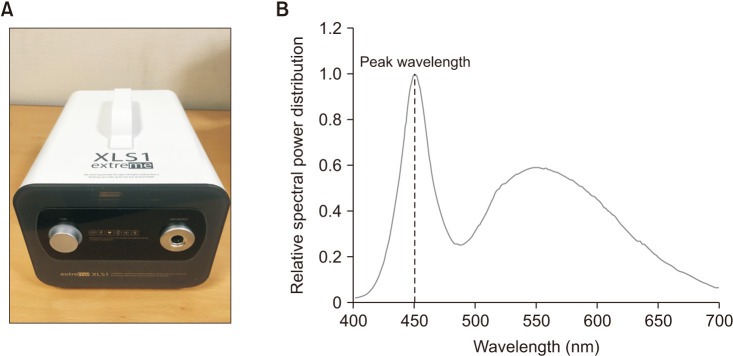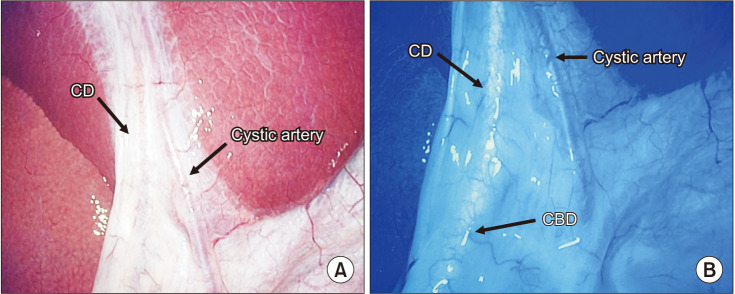Ann Surg Treat Res.
2023 Mar;104(3):144-149. 10.4174/astr.2023.104.3.144.
Laparoscopic fluorescence imaging technique for visualizing biliary structures using sodium fluorescein: the result of a preclinical study in a porcine model
- Affiliations
-
- 1Department of Surgery, Korea University Ansan Hospital, Ansan, Korea
- 2Department of Surgery, Korea University College of Medicine, Seoul, Korea
- KMID: 2539692
- DOI: http://doi.org/10.4174/astr.2023.104.3.144
Abstract
- Purpose
Near-infrared fluorescence imaging has been recently applied in the field of hepatobiliary surgery. Our objective was to apply blue-light fluorescence cholangiography during laparoscopic surgery. Therefore, we designed a preclinical study to evaluate the feasibility of using blue-light fluorescence for cholangiography in a porcine model.
Methods
Five millimeters of sodium fluorescein (SF) solution was administered into the gallbladder of 20 male 3-way crossbred (Landrace × Yorkshire × Duroc) pigs in laparoscopic approach. The biliary tree was observed under blue light (a peak wavelength of 450 nm) emitted from a commercialized light-emitting diode (LED) light source (XLS1 extreme, Chammed).
Results
In 18 of 20 porcine models, immediately after SF solution was administered into the gallbladder, it was possible to visualize the biliary tree under blue light emitted from the LED light source.
Conclusion
This study provided a preclinical basis for using blue-light fluorescence cholangiography using SF in laparoscopic surgery. The clinical feasibility of blue-light fluorescence imaging techniques for laparoscopic cholecystectomy remained to be demonstrated.
Keyword
Figure
Reference
-
1. Chang YW, Lee HY, Lee CM, Jung SP, Kim WY, Woo SU, et al. Sentinel lymph node detection using fluorescein and blue light-emitting diodes in patients with breast carcinoma: a single-center prospective study. Asian J Surg. 2020; 43:220–226. PMID: 30904399.2. Yamada Y, Ohno M, Fujino A, Kanamori Y, Irie R, Yoshioka T, et al. Fluorescence-guided surgery for hepatoblastoma with indocyanine green. Cancers (Basel). 2019; 11:1215. PMID: 31434361.3. Reinhart MB, Huntington CR, Blair LJ, Heniford BT, Augenstein VA. Indocyanine green: historical context, current applications, and future considerations. Surg Innov. 2016; 23:166–175. PMID: 26359355.4. Landsman ML, Kwant G, Mook GA, Zijlstra WG. Light-absorbing properties, stability, and spectral stabilization of indocyanine green. J Appl Physiol. 1976; 40:575–583. PMID: 776922.5. Keleman AM, Imagawa DK, Findeiss L, Hanna MH, Tan VH, Katz MH, et al. Associated vascular injury in patients with bile duct injury during cholecystectomy. Am Surg. 2011; 77:1330–1333. PMID: 22127081.6. Ishizawa T, Bandai Y, Ijichi M, Kaneko J, Hasegawa K, Kokudo N. Fluorescent cholangiography illuminating the biliary tree during laparoscopic cholecystectomy. Br J Surg. 2010; 97:1369–1377. PMID: 20623766.7. Ishizawa T, Kaneko J, Inoue Y, Takemura N, Seyama Y, Aoki T, et al. Application of fluorescent cholangiography to single-incision laparoscopic cholecystectomy. Surg Endosc. 2011; 25:2631–2636. PMID: 21424202.8. Verbeek FP, Schaafsma BE, Tummers QR, van der Vorst JR, van der Made WJ, Baeten CI, et al. Optimization of near-infrared fluorescence cholangiography for open and laparoscopic surgery. Surg Endosc. 2014; 28:1076–1082. PMID: 24232054.9. Ishizawa T, Bandai Y, Kokudo N. Fluorescent cholangiography using indocyanine green for laparoscopic cholecystectomy: an initial experience. Arch Surg. 2009; 144:381–382. PMID: 19380655.10. Lee CM, Park S, Park SH, Jung SW, Choe JW, Sul JY, et al. Sentinel node mapping using a fluorescent dye and visible light during laparoscopic gastrectomy for early gastric cancer: result of a prospective study from a single institute. Ann Surg. 2017; 265:766–773. PMID: 27058946.11. Yoon SY, Lee CM, Song TJ, Han HJ, Kim S. A new fluorescence imaging technique for visualizing hepatobiliary structures using sodium fluorescein: result of a preclinical study in a rat model. Surg Endosc. 2018; 32:2076–2083. PMID: 29067576.12. Lee CM, Jeong MY, Yoon SY. Laparoscopic liver resection enhanced by an intervention-guided fluorescence imaging technique using sodium fluorescein. J Clin Med. 2021; 10:3663. PMID: 34441959.13. Ke Y, Zhang H, Hei K, Shi Y, Li X, Zhang L. Application of iris fluorescein angiography in diabetic iridopathy and retinopathy in brown iris. Eur J Ophthalmol. 2022; 32:1092–1100.14. Xu K, Tzankova V, Li C, Sharma S. Intravenous fluorescein angiography-associated adverse reactions. Can J Ophthalmol. 2016; 51:321–325. PMID: 27769320.15. Dip FD, Nahmod M, Anzorena FS, Moreira A, Sarotto L, Ampudia C, et al. Novel technique for identification of ureters using sodium fluorescein. Surg Endosc. 2014; 28:2730–2733. PMID: 24737531.16. Roberts HW, Donati-Bourne JF, Wilson VL, Wilton JC. The use of live fluorescence staining techniques in surgery: a review. J Invest Surg. 2013; 26:283–293. PMID: 23617319.17. Belli A, Fantini C, Cioffi L, D’Agostino A, Belli G. Mils for HCC: the state of art. Updates Surg. 2015; 67:105–109. PMID: 26164139.18. Ban D, Nishino H, Ohtsuka T, Nagakawa Y, Abu Hilal M, Asbun HJ, et al. International expert consensus on precision anatomy for minimally invasive distal pancreatectomy: PAM-HBP surgery project. J Hepatobiliary Pancreat Sci. 2022; 29:161–173. PMID: 34719123.19. Nagakawa Y, Nakata K, Nishino H, Ohtsuka T, Ban D, Asbun HJ, et al. International expert consensus on precision anatomy for minimally invasive pancreatoduodenectomy: PAM-HBP surgery project. J Hepatobiliary Pancreat Sci. 2022; 29:124–135. PMID: 34783176.20. Edwin B, Sahakyan MA, Abu Hilal M, Besselink MG, Braga M, Fabre JM, et al. Laparoscopic surgery for pancreatic neoplasms: the European association for endoscopic surgery clinical consensus conference. Surg Endosc. 2017; 31:2023–2041. PMID: 28205034.21. Güneş Y, Bostancı Ö, İlbar Tartar R, Battal M. Xanthogranulomatous cholecystitis: is surgery difficult?: is laparoscopic surgery recommended? J Laparoendosc Adv Surg Tech A. 2021; 31:36–40. PMID: 32559394.22. Kono Y, Ishizawa T, Tani K, Harada N, Kaneko J, Saiura A, et al. Techniques of fluorescence cholangiography during laparoscopic cholecystectomy for better delineation of the bile duct anatomy. Medicine (Baltimore). 2015; 94:e1005. PMID: 26107666.23. Ishizawa T, Saiura A, Kokudo N. Clinical application of indocyanine green-fluorescence imaging during hepatectomy. Hepatobiliary Surg Nutr. 2016; 5:322–328. PMID: 27500144.24. Lira RP, Oliveira CL, Marques MV, Silva AR, Pessoa Cde C. Adverse reactions of fluorescein angiography: a prospective study. Arq Bras Oftalmol. 2007; 70:615–618. PMID: 17906757.25. Marmor MF, Ravin JG. Fluorescein angiography: insight and serendipity a half century ago. Arch Ophthalmol. 2011; 129:943–948. PMID: 21746986.26. Mohsen A, Elbasiouny MS, El-Shazli M, Azmy O, Amr A. Evaluation of the effectiveness of fluorescent visualization of bile ducts using fluorescein and ultraviolet A at laparoscopic cholecystectomy. Surg Innov. 2016; 23:261–265. PMID: 26567271.27. Mohsen AA, Elbasiouny MS, Fawzy YS. Fluorescence-guided laparoscopic cholecystectomy: a new technique for visualization of biliary system by using fluorescein. Surg Innov. 2013; 20:105–108. PMID: 22474014.




